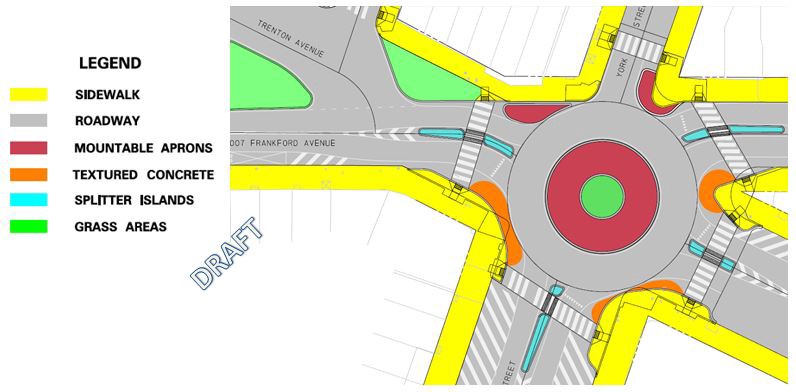Both Frankford Avenue and York Street are part of the city’s High Injury Network.

Representatives from the city Department of Streets gathered in the auditorium of Horatio B. Hackett School on Wednesday evening to detail plans and gather feedback for a planned roundabout at the intersection of Frankford Avenue, Trenton Street and York Street near the border of Fishtown and Kensington. According to representatives at the meeting, the intersection was selected as one of a number of locations around the city for being at a particularly high-risk area. Plans for the roundabout are a result of the city’s Vision Zero commitment, which is an international project that started in Sweden that “seeks to eliminate all traffic fatalities and severe injuries nationwide.”
According to the city’s vision zero program, 50 percent of all traffic deaths and severe injuries occurred on just 12 percent of Philadelphia streets, and that 12 percent of streets comprises something called the High Injury Network. Both Frankford Avenue and York Street are part of the High Injury Network.
According to data provided by PennDOT, there were six total crashes at the intersection from 2013 to 2017, which is the most recent data. Three of the accidents involved cars hit at an angle, one involved a car hitting a fixed object, one was a rear-ending, and the last was a “same direction sideswipe.” None of the accidents resulted in fatalities or serious injuries. One of the crashes resulted in a “minor” injury, two of the crashes had a “possible injury” and another crash had an injury of “unknown severity,” according to the PennDOT statistics.
A PennDOT study completed last year revealed the following results at 11 different intersections in Pennsylvania after roundabouts were installed: fatalities were reduced by 100 percent (from two to zero); serious injuries were reduced by 100 percent (from seven to zero); minor injuries were reduced by 95 percent (from 19 to one); possible/unknown severity injuries were reduced by 92 percent (from 49 to four); crashes causing only property damage decreased by 2 percent (from 49 to 48); and the total number of crashes dropped 47 percent (from 101 to 54). The data was based on police-submitted crash reports spanning the years 2000 through 2017.
“Our data shows that modern-day roundabouts reduce crash severity and injuries while improving traffic flow,” said PennDOT Secretary Leslie S. Richards at the time. “This underscores why roundabouts are becoming more commonplace in Pennsylvania and beyond.”
Gus Scheerbaum, Director of Strategic Initiatives for the city’s streets department, elaborated on that point: “The physical geometry of the new intersection forces people to drive more carefully and slowly throughout the intersection,” he said. “When the light is green at a signalized intersection, people are driving at full speed and can even be speeding. People will also drive through the light not realizing that it was changing to yellow or even red and they run it, and that’s when crashes often occur. Speed is what injures people.”
Streets department representatives repeatedly referred to the roundabout as a “modern roundabout,” which the Federal Highway Safety Administration defines as “circular intersections with specific design and traffic control features. These features include yield control of all entering traffic, channelized approaches, and appropriate geometric curvature to ensure that travel speeds on the circulatory roadway are typically less than 30 mph.”
Scheerbaum said he didn’t yet know how much the roundabout would cost, but said that the department targets roundabouts to typically cost within the $500,000 to $800,000 range. Construction would likely take about two months if the intersection were to be closed for construction. Without full road closure, Scheerbaum said construction could take up to a year. During construction, the streets department would coordinate with SEPTA to make sure a detour route for the 5 bus is prepared.
Scheerbaum insisted that the project does more than increase safety, however; it saves money.
“The initial cost for a roundabout is almost twice as much as it costs to put new signals in,” Scheerbaum said, “but it’s more affordable in the long run because there’s less maintenance.”
The roundabout would be the first of its kind in the area, but not the first in Philadelphia. As it stands, there’s currently several others, including one in East Falls and two more in Fairmount Park.
Hackett Principal Todd Kimmel, who was at the meeting, said that he was initially skeptical of the roundabout but came around to it.
“It sounds like a good idea,” he said. “As it is, it’s very difficult to cross for kids and adults.”
Currently, the school has a crossing guard at the intersection. Kimmel said he’d like to see two crossing guards there if the roundabout were to come about. However, Kimmel said that decision would ultimately be up to the 26th Police District.
